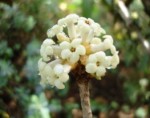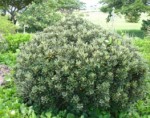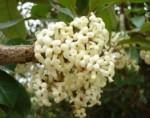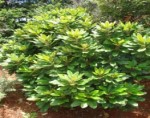Scientific Name: Pittosporum hosmeri
Endemic: Hawaii Island Only
Description: These are usually small trees up to about 20-25 ft. tall with long tear-drop shaped leaves. The young leaves as well as the underside of the more mature leaves are usually covered with minute, golden-brown hairs. Their flowers emerge as “manapua” shaped clusters which protrude right out of the stems. Once pollinated, they develop into large nut shaped capsules that are almost cubicle in form and about three inches long and 1-2 inches wide. Inside are numerous reddish-black seeds which totally stand out against the bright orange inner surface of the seed capsule.
Distribution: This plant is only found on the island of Hawai’i but through out leeward side from Kohala to Ka’u in mesic forests.
Cultural Uses: There isn’t much known about this plant from a cultural point of view but in nature it is interesting to see the seed capsules when they become ripe. At this point they open up by fold back and exposing the bright orange inner surface and dark seeds within. This is to attract birds that feed on the oily seeds and help the plant with seed dispersal. In fact this is one of the favorite foods of the nearly extinct Hawaiian crow the ‘alala.
Landscape Uses and Care: Easily one of the nicest foliage plants native to Hawaii these plants do great in full sun to partial shade in well drained soil with little to moderate watering. The foliage along with the unique form of the flower clusters and stunning seed capsules make this an extraordinary plant. If left alone to grow it will be a large bush but full of foliage from bottom to top. Few pests bother this plant once it is established in the ground but prior to that happening watch out for mealy bugs, scale and the formation of sooty mold. If you notice these pests on the plant you can simply treat it with a store bought pesticide and fungicide being sure to follow the directions on the bottle carefully. Right now beautiful specimens of this plant in three gallon pots are available at Hui Ku Maoli Ola native plant nursery for $40.
Additional Info: This plant also goes by the name ha’awa, a’awa, a’awa hua kukui. The latter name ‘a’awa hua kukui probably stems from the fact that this plant’s fruit (hua) somewhat resembles that of a kukui nut.
Hoawa



